Where to dig in?
As you start gardening, focus on gardening essentials such as hand tools like hand trowels and pruners. Critical digging tools include garden forks and shovels. For soil preparation, use cultivators and rakes. Pruning tools like pruning shears and saws are vital. For maintenance, rely on spades, rakes, and wheelbarrows. Maintain proper posture and clean tools to guarantee efficiency. By mastering these basics, you’ll be well on your way to making your garden thrive—explore further to refine your gardening skills.
Essential Gardening Hand Tools
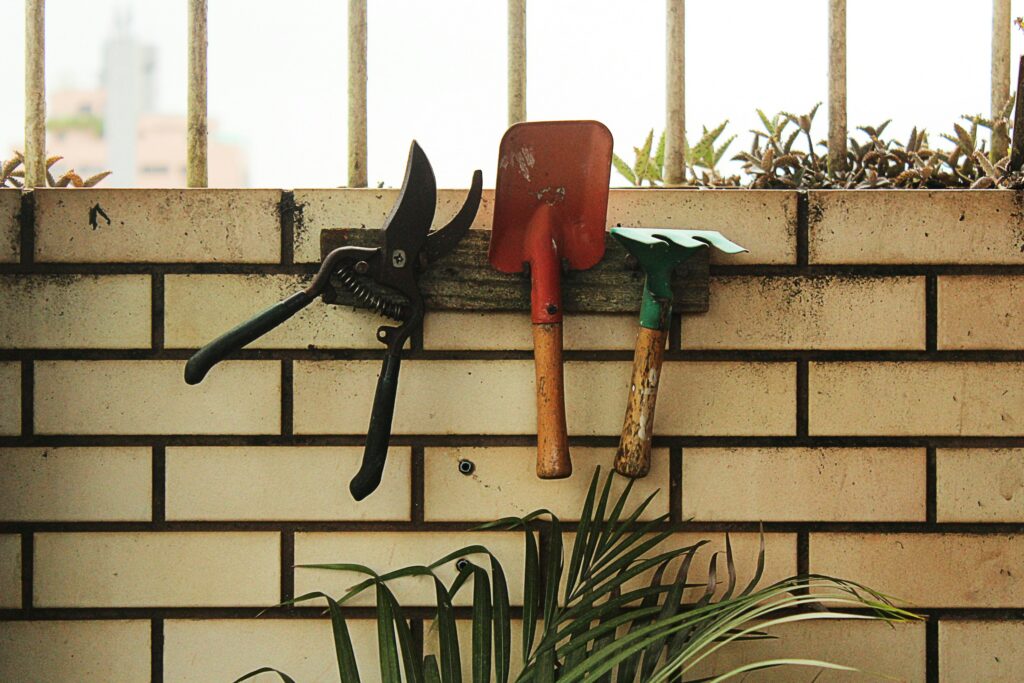
Next, focus on weeding and soil cultivation tools. Start with hand cultivators, which loosen and aerate soil while removing weeds in garden beds. Use an L-blade weeder to target weeds in tight spots and cracks precisely. Multi-point seed tray dibblers help you plant seeds at uniform depth and spacing for even growth. The Niwaki Weeding Hoe is appreciated for its versatility and sharp blade, suitable for different types of soil and situations.
Hand rakes clear leaves and small debris from raised beds and confined spaces efficiently. Their flexible, fan-shaped tines prevent damaging plants while cleaning tight spaces like flower beds and dense bushes. For compacted soil, a broadfork or grelinette loosens without turning, improving drainage and encouraging root growth. These tools work together to prepare your garden for healthy plants by maintaining soil structure and cleanliness. Using them correctly will make your soil more fertile and your garden easier to manage.
Critical Gardening Digging Tools
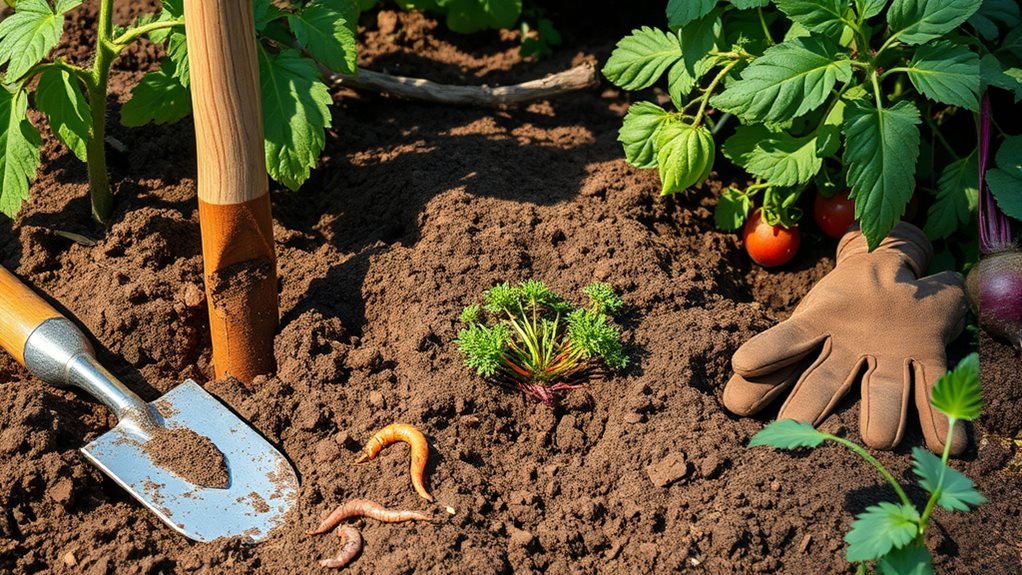
When it comes to gardening, having the right digging tools at your disposal can make a significant difference in the efficiency and effectiveness of your work.
Having the right digging tools boosts gardening efficiency and effectiveness.
Use garden forks with straight, square tines to loosen compacted or rocky soil; their strong design resists bending. A top choice is the Greenman stainless steel border fork known for its balance and pointed tines, which enhance digging precision.
Choose hand trowels with broad blades for moving soil or narrow blades for digging around rocks and weeds.
Shovels, ranging from hand-sized to full-sized, are great for digging deep holes and moving soil efficiently.
A hori hori knife offers versatility with a long blade, serrated edge, and depth markings for precise planting.
Dibbers create consistent holes at exact depths, ensuring proper seed and bulb placement.
Regular cutting back with sharp tools supports plant health by encouraging growth, controlling size, and preventing disease—making it an essential gardening practice.
Look for stainless steel tools with ergonomic handles, keep blades sharp, clean after use, and store them dry to maintain longevity.
Soil Preparation Tools
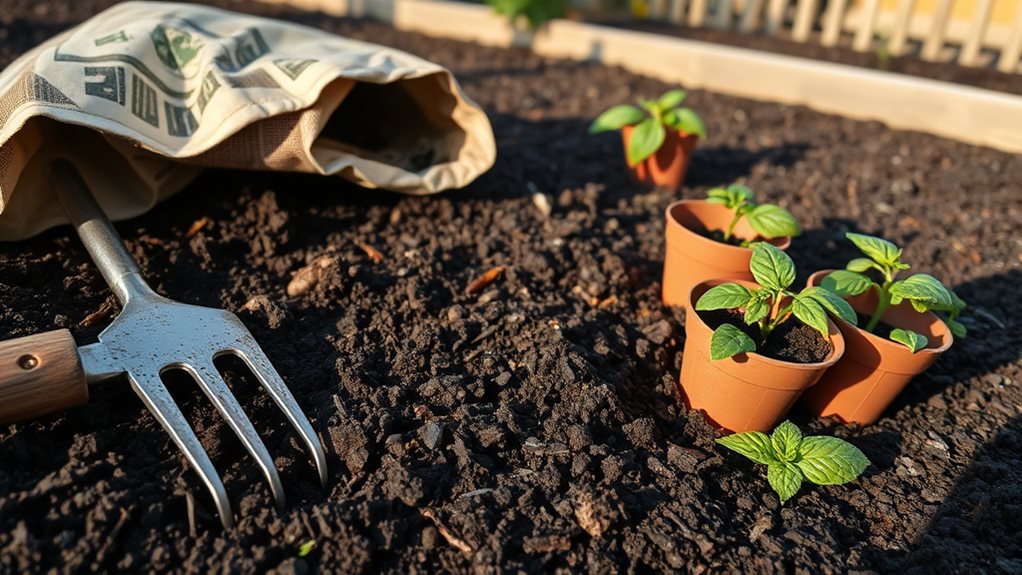
Preparing your soil for planting involves using a variety of specialized tools to guarantee it’s fertile and well-structured. The right tools help loosen compacted areas, mix in amendments, and remove debris, setting the stage for healthy plant growth.
- Garden Forks are perfect for loosening and aerating soil, especially if it’s dense or rocky. Choose forged steel tines for durability and ergonomic handles for comfort.
- Cultivators break up tougher soil that forks can’t manage, which is essential for compacted or clay-heavy soils.
- Rakes level and smooth the soil surface, making it ready for planting by removing small rocks and debris.
Using these tools properly improves aeration, allows roots to penetrate easily, and helps you incorporate organic matter effectively for better soil structure. Additionally, maintaining a balanced loamy soil texture is crucial for optimal plant growth, as it provides better nutrient retention and drainage. Understanding the different soil types can help gardeners optimize their plants’ growth conditions.
Gardening Pruning Tools
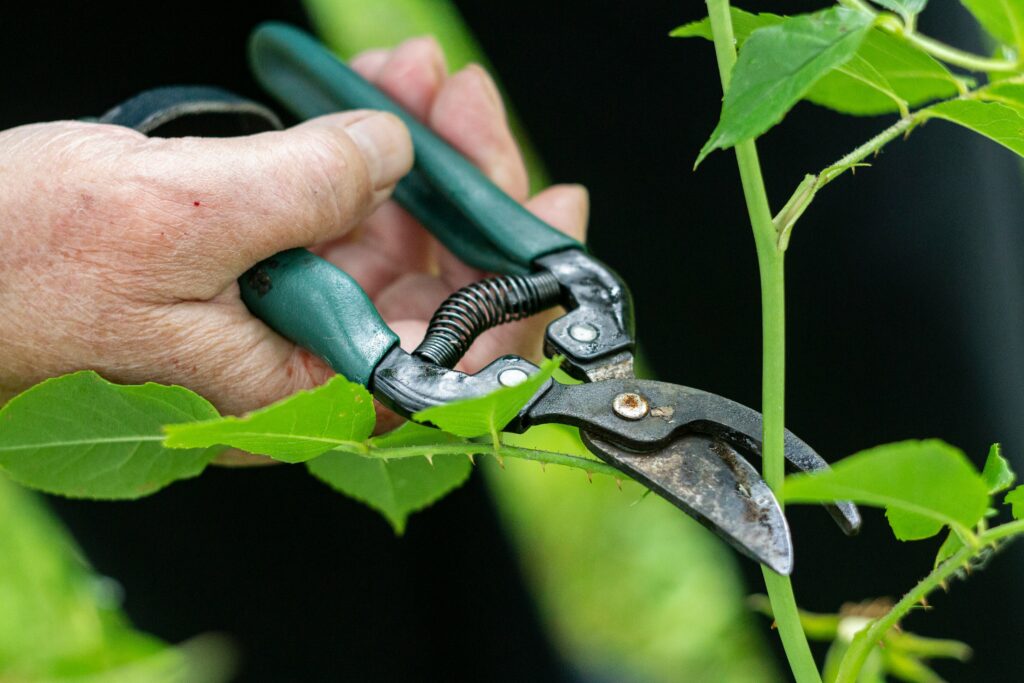
Having prepared your soil for planting, you now need to focus on maintaining the health and appearance of your plants. Proper pruning tools are vital for this task.
Gardening Pruning Tools
You’ll need pruning shears for soft stems, loppears for thicker branches, pruning saws for thicker cuts, pole pruners for high branches, and hedge shears for hedges. Bypass secateurs cut living stems without crushing them, while anvil secateurs are best for dead wood. Ergonomic handles and sharp blades guarantee comfort and safety. Regular maintenance and proper tool selection are essential for efficient pruning. For cutting small stems up to 1/2 inch thick, bypass hand pruners provide clean cuts without damaging the plant. Among the quality shears, the Kent and Stowe Eversharp Bypass Secateurs stand out for their capability to cut both live and dead wood, ensuring versatility in every gardener’s toolkit.
Garden Maintenance Tools
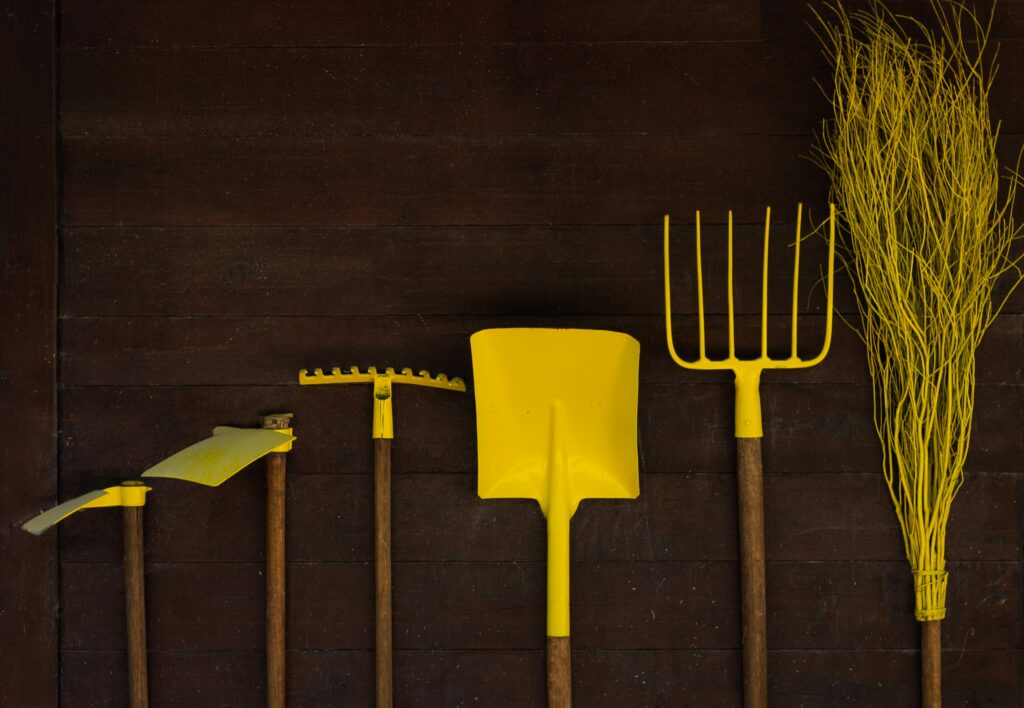
These tasks require a systematic approach to guarantee your garden remains healthy and visually appealing. Effective garden maintenance involves a variety of tools, each designed for specific tasks.
- Spade and Shovel: Used for heavy-duty digging and moving soil, these tools are indispensable for planting new flowers or trees. Additionally, a hand trowel is perfect for precise planting and transplanting in tighter garden spaces.
- Rake and Hoe: These tools help level the soil and control weeds, ensuring a well-manicured garden appearance.
- Leaf Rake and Wheeled Cart: These tools are essential for collecting leaves and transporting heavy debris, making cleanup easier and more efficient. Proper use of these tools often involves maintaining a straight back to prevent back strain and ensure safe gardening practices.
Essential Gardening Miscellaneous Tools
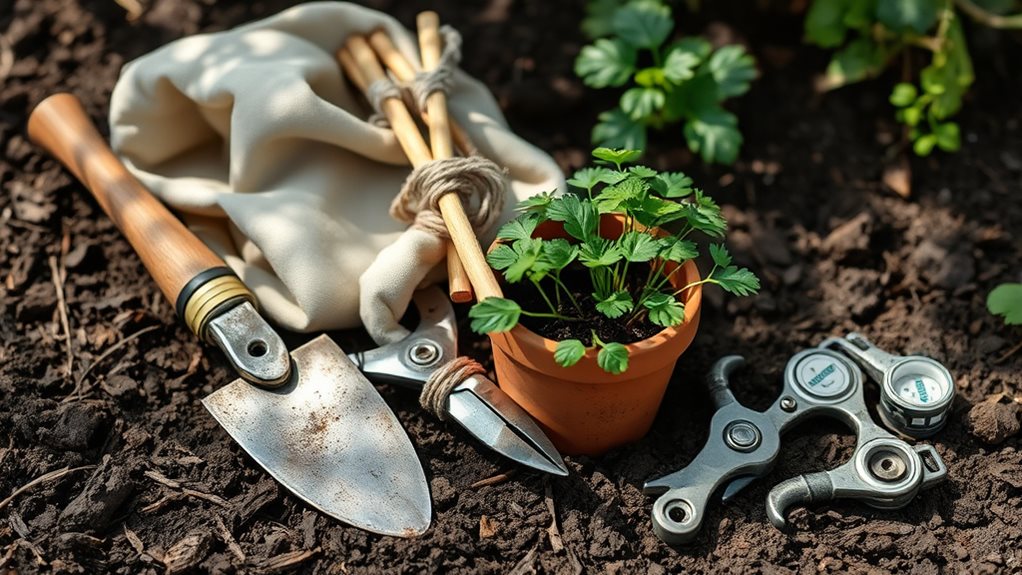
Garden maintenance tools focus on preparing and shaping the soil, digging, and clearing debris, but your gardening experience also depends heavily on having the right miscellaneous tools to manage other tasks efficiently. These tools help with tasks like transporting materials, protecting your hands, and collecting produce. Additionally, effective gardening often requires the use of versatile tools such as scissors, which are valuable for tasks like deadheading flowers and harvesting small vegetables. Moreover, expandable hoses like the Hydrotech Pro Series Expandable Max-Flow Hose are praised for their lightweight and kink-free features, making them ideal for stress-free watering.
Essential Miscellaneous Tools:
- Gardening Gloves: Protect your hands from thorns and dirt.
- Wheelbarrows: Transport soil, tools, and plants around the garden.
- Weeders: Remove weeds without damaging other plants.
- Garden Baskets: Collect harvested produce efficiently.
- Garden Carts: Carry tools and supplies across the garden, making it easier to manage tasks.
Gardening for Beginners
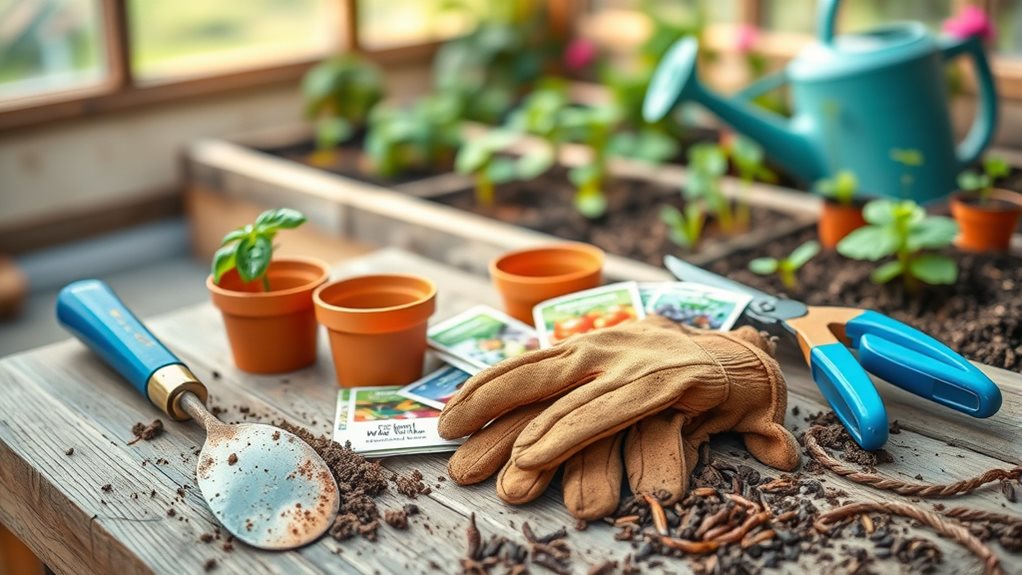
When you start gardening, it’s vital to approach the process with a clear plan and the right mindset. Your garden’s success depends on several key factors.
- Determine Garden Aspect: Identify if your garden faces south or north to choose plants that thrive under those conditions. Assess the area’s sunlight exposure to ensure it meets the required 6-8 hours of daily sun.
- Soil Type and Preparation: Determine your soil type and prepare it by testing pH levels, adding compost, and mulch.
- Plant Selection: Choose plants that complement each other in the context of color, structure, and growth conditions, ensuring a balanced garden throughout the year. To ensure optimal growth, it is crucial to select a location that receives direct sunlight for at least six to eight hours daily.
Advanced Gardening Techniques
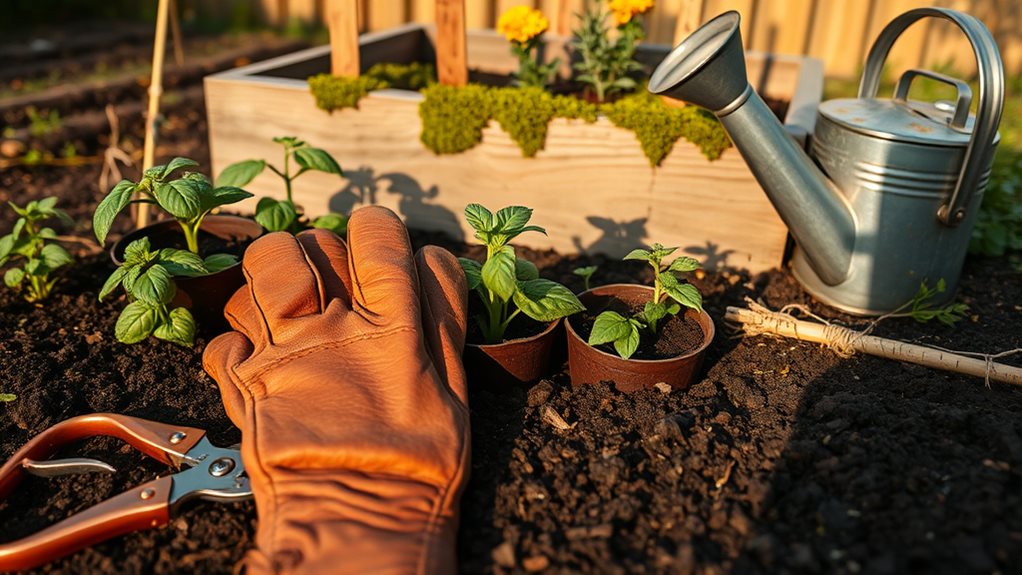
Advanced gardening techniques help you refine your skills and boost your garden’s productivity by using methods that enhance plant health, growth, and space efficiency. You can utilize techniques like hydroponics and aquaponics for efficient nutrient delivery. Hydroponics allows for faster growth and higher yields, using less water compared to traditional soil-based systems. Companion planting and grafting are also valuable for pest control and climate adaptation. Furthermore, incorporating practices like composting can significantly improve soil health, leading to more resilient and thriving gardens.
| Technique | Description |
|---|---|
| Vertical Gardening | Maximizes space |
| Raised Beds | Improves drainage |
| Hügelkultur | Enhances soil fertility |
These advanced methods offer a range of benefits, from better plant health to increased yields, all while conserving resources and space.
Frequently Asked Questions
How Often Should I Inspect My Gardening Tools?
You should inspect your gardening tools regularly based on their usage. For tools used daily, inspect them weekly. Less frequently used tools may need inspection once a month.
Additionally, perform seasonal checks for items like lawn mowers, which require oil changes at the start of each mowing season. Always check tools for signs of dullness or damage, sharpening or repairing them as needed.
What Causes Rust on Gardening Tools?
Rust forms on gardening tools when iron or steel reacts with oxygen and moisture, causing oxidation. You cause rust by letting tools stay wet, dirty, or stored in damp places.
Temperature changes and debris trap moisture, speeding rust. To reduce rust, clean and dry tools after use, store them in dry spots, and oil metal surfaces regularly. Using rust-resistant materials like stainless steel also helps protect your tools.
How Do I Properly Store Gardening Tools?
To properly store your gardening tools, consider the following methods:
- Wall Mounting: Use hooks or racks on walls to save space.
- Dry Storage: Keep tools in a dry area to prevent rust.
- Organization: Store tools neatly to reduce wear and tear.
Position storage near the garden entrance for easy access and incorporate clean storage practices to maintain tool durability.
Can I Use Gardening Tools for Other Outdoor Tasks?
You can use gardening tools for various outdoor tasks beyond gardening. Garden forks are handy for turning compost and breaking up clumps.
Rakes work well for collecting leaves or debris in yards or parks. Loppers and pruning shears are useful for trimming branches in non-garden areas. Always wear safety gear and maintain tools regularly to safeguard efficiency and safety.
How Do I Maintain Tool Handles?
To maintain tool handles:
- Cleanliness: Wipe down handles with a damp cloth after use, and guarantee they’re dry before storage.
- Inspection: Check frequently for cracks or weakening.
- Restoration: Use sandpaper to smooth damaged areas, then apply oil like linseed or tung oil.
- Storage: Store in a dry area with good air circulation.
Conclusion
You’re now equipped with the essential tools for a thriving garden. Hand tools like pruners and trowels help with precision tasks, while digging tools like shovels and spades handle heavier work. Soil preparation tools like hoes guarantee your soil is ready for planting. Pruning tools, including loppers and shears, keep your garden tidy. For maintenance, use rakes and wheelbarrows, and don’t forget gloves for protection. These tools will support you in creating a beautiful outdoor space.

